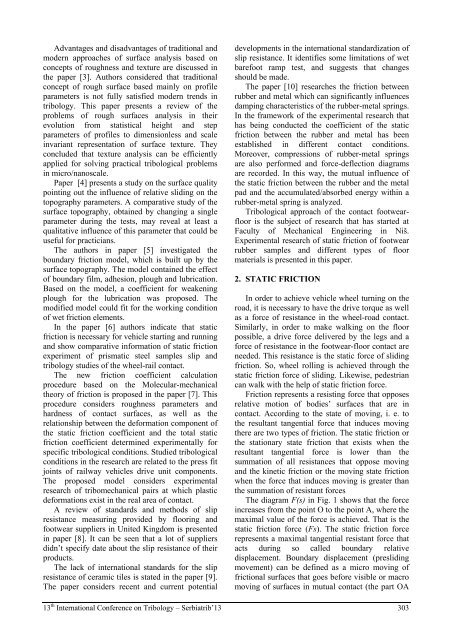Proceedings of SerbiaTrib '13
Proceedings of SerbiaTrib '13
Proceedings of SerbiaTrib '13
- No tags were found...
Create successful ePaper yourself
Turn your PDF publications into a flip-book with our unique Google optimized e-Paper software.
Advantages and disadvantages <strong>of</strong> traditional andmodern approaches <strong>of</strong> surface analysis based onconcepts <strong>of</strong> roughness and texture are discussed inthe paper [3]. Authors considered that traditionalconcept <strong>of</strong> rough surface based mainly on pr<strong>of</strong>ileparameters is not fully satisfied modern trends intribology. This paper presents a review <strong>of</strong> theproblems <strong>of</strong> rough surfaces analysis in theirevolution from statistical height and stepparameters <strong>of</strong> pr<strong>of</strong>iles to dimensionless and scaleinvariant representation <strong>of</strong> surface texture. Theyconcluded that texture analysis can be efficientlyapplied for solving practical tribological problemsin micro/nanoscale.Paper [4] presents a study on the surface qualitypointing out the influence <strong>of</strong> relative sliding on thetopography parameters. A comparative study <strong>of</strong> thesurface topography, obtained by changing a singleparameter during the tests, may reveal at least aqualitative influence <strong>of</strong> this parameter that could beuseful for practicians.The authors in paper [5] investigated theboundary friction model, which is built up by thesurface topography. The model contained the effect<strong>of</strong> boundary film, adhesion, plough and lubrication.Based on the model, a coefficient for weakeningplough for the lubrication was proposed. Themodified model could fit for the working condition<strong>of</strong> wet friction elements.In the paper [6] authors indicate that staticfriction is necessary for vehicle starting and runningand show comparative information <strong>of</strong> static frictionexperiment <strong>of</strong> prismatic steel samples slip andtribology studies <strong>of</strong> the wheel-rail contact.The new friction coefficient calculationprocedure based on the Molecular-mechanicaltheory <strong>of</strong> friction is proposed in the paper [7]. Thisprocedure considers roughness parameters andhardness <strong>of</strong> contact surfaces, as well as therelationship between the deformation component <strong>of</strong>the static friction coefficient and the total staticfriction coefficient determined experimentally forspecific tribological conditions. Studied tribologicalconditions in the research are related to the press fitjoints <strong>of</strong> railway vehicles drive unit components.The proposed model considers experimentalresearch <strong>of</strong> tribomechanical pairs at which plasticdeformations exist in the real area <strong>of</strong> contact.A review <strong>of</strong> standards and methods <strong>of</strong> slipresistance measuring provided by flooring andfootwear suppliers in United Kingdom is presentedin paper [8]. It can be seen that a lot <strong>of</strong> suppliersdidn’t specify date about the slip resistance <strong>of</strong> theirproducts.The lack <strong>of</strong> international standards for the slipresistance <strong>of</strong> ceramic tiles is stated in the paper [9].The paper considers recent and current potentialdevelopments in the international standardization <strong>of</strong>slip resistance. It identifies some limitations <strong>of</strong> wetbarefoot ramp test, and suggests that changesshould be made.The paper [10] researches the friction betweenrubber and metal which can significantly influencesdamping characteristics <strong>of</strong> the rubber-metal springs.In the framework <strong>of</strong> the experimental research thathas being conducted the coefficient <strong>of</strong> the staticfriction between the rubber and metal has beenestablished in different contact conditions.Moreover, compressions <strong>of</strong> rubber-metal springsare also performed and force-deflection diagramsare recorded. In this way, the mutual influence <strong>of</strong>the static friction between the rubber and the metalpad and the accumulated/absorbed energy within arubber-metal spring is analyzed.Tribological approach <strong>of</strong> the contact footwearflooris the subject <strong>of</strong> research that has started atFaculty <strong>of</strong> Mechanical Engineering in Niš.Experimental research <strong>of</strong> static friction <strong>of</strong> footwearrubber samples and different types <strong>of</strong> floormaterials is presented in this paper.2. STATIC FRICTIONIn order to achieve vehicle wheel turning on theroad, it is necessary to have the drive torque as wellas a force <strong>of</strong> resistance in the wheel-road contact.Similarly, in order to make walking on the floorpossible, a drive force delivered by the legs and aforce <strong>of</strong> resistance in the footwear-floor contact areneeded. This resistance is the static force <strong>of</strong> slidingfriction. So, wheel rolling is achieved through thestatic friction force <strong>of</strong> sliding. Likewise, pedestriancan walk with the help <strong>of</strong> static friction force.Friction represents a resisting force that opposesrelative motion <strong>of</strong> bodies’ surfaces that are incontact. According to the state <strong>of</strong> moving, i. e. tothe resultant tangential force that induces movingthere are two types <strong>of</strong> friction. The static friction orthe stationary state friction that exists when theresultant tangential force is lower than thesummation <strong>of</strong> all resistances that oppose movingand the kinetic friction or the moving state frictionwhen the force that induces moving is greater thanthe summation <strong>of</strong> resistant forcesThe diagram F(s) in Fig. 1 shows that the forceincreases from the point O to the point A, where themaximal value <strong>of</strong> the force is achieved. That is thestatic friction force (Fs). The static friction forcerepresents a maximal tangential resistant force thatacts during so called boundary relativedisplacement. Boundary displacement (preslidingmovement) can be defined as a micro moving <strong>of</strong>frictional surfaces that goes before visible or macromoving <strong>of</strong> surfaces in mutual contact (the part OA13 th International Conference on Tribology – Serbiatrib’13 303
















